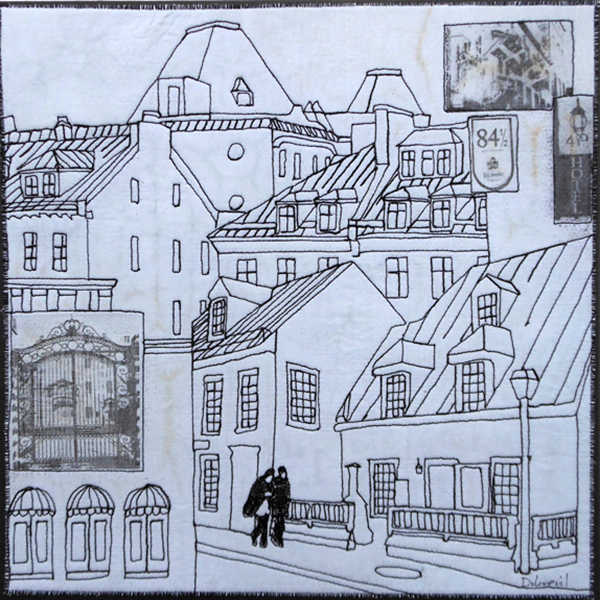I recently returned from a fabulous 5-day workshop with
Jane Davies, held on the bucolic
Omega campus in Rhinebeck, New York. While the course was titled
100 Paintings, Drawings and Explorations, I probably made no more than sixty. The value in the experience was not about the volume of work produced, but about taking more artistic risks. The teacher set quite a pace, which is what you would expect given the name of the class.
The first exercise was to paint to music. With each musical selection lasting only 2 - 4 minutes, we worked on large paper, and tried to suspend judgment about the quality of the painting. We did about ten of these.
 |
| painting to music |
 |
| painting to music |
 |
| painting to music |
At another point, we set a timer and worked on smaller paintings for five minutes. The idea here was that there are many pivotal artistic decisions that one can make, even in the course of a 5-minute painting. Again we made perhaps ten of these.
 |
| 5-minute painting |
 |
| 5-minute painting |
 |
| 5-minute painting |
For both of these activities, I was glad to have brought a selection of student-grade acrylics. No concerns about using expensive resources for these experiments.
We looked at line and the many kinds of line that can be made with various materials, lines that are curved or straight, jagged or broken, smudgy or clean, tangled or direct. We were told to make at least six compositions, each made with 5 - 7 lines that were as different as possible from each other.
 |
| Six lines |
We also looked at shape, and the many ways that shapes can be made: as outlines or filled in, soft-edged or hard-edged, with masks and stencils, and with a wide variety of materials.
Exercises were assigned, each one with specific parameters. For example, put down two painted shapes. Then add a collaged shape, and another two or three elements, which could be collage, line or pattern. Make 10 - 12 variations on this.
The next assignment was similar, but we paid more attention to a variety of scale.
 |
|
Jane is a big advocate of setting up limitations and then finding many variations within those "rules". She believes that when you meet with frustration with the format, you should persist with it. By making the effort to overcome the difficulties of the format, you can actually learn something valuable. Don't be too quick to crop the piece down so that it "works". Don't be too quick to cut up an unsatisfactory piece to use as collaged bits. Instead, transform it with paint into something with new possibilities. "It's only paint", said Jane, and the sky won't fall.
Interspersed with these exercises were slide shows, illustrating some of the ideas with hundreds of stunning abstract works by a number of different contemporary artists. We also benefited from the pithy insights of the instructor on a variety of topics.
At one point, Jane showed us how to make "grounds", achieving variation and depth by making many layers of both opaque and transparent paint, by lifting wet paint off with paper, by spritzing and then blotting, by scratching a line into the wet paint, and by using a brayer.
Using this interesting ground, we then created one or two negative shapes by masking, applying white paint with a brayer around the shape and making a semi-transparent, foggy layer. We then added another three or four shapes, using a variety of materials and techniques. I was very excited by this assignment, and was able to make more than a dozen interesting compositions.
Jane pointed out that I had a tendency to distribute my shapes over the whole space, and that I should try to create some "breathing space".
 |
| Not much breathing space |
 |
| A bit more breathing space |
She also advised us to make shapes that contrast with each other. If one is transparent, try another that is opaque. If one is mottled, make another that is pure, flat colour. If one is hard-edged, make another with a smudgy edge. If one is solid, another can be just an outline. If you're introducing colour into a neutral composition, make it a brilliant colour, for contrast.
 |
| addition of brilliant colour for contrast |
I was also encouraged to pay attention to the white "fog" surrounding my shapes, to make it interesting, and have it thicken and fade across the space. For someone with little experience with acrylic, this was instructive. When I said to Jane, "I have trouble making the paint do what I want it to do," she answered, "So do I."
 |
| trying to get variation in the depth of the white "fog" |
I have mounted fifteen of these compositions, and I think they will be just the thing to spark interest at the upcoming Fall Show of the Hudson Artists.
The workshop was a great experience. And as so often happens, I learned a lot from the other participants as well as from the instructor. My goal in taking these classes in painting is to develop my abstract imagery, and Jane pointed out that I now have some "personal" visual vocabulary that I can explore further.
Jane Davies teaches all over the U.S., and occasionally in Canada. If you'd like to find out more about her workshops, her on-line classes and her instruction downloads, check out her
website. It's full of information and resources.



































